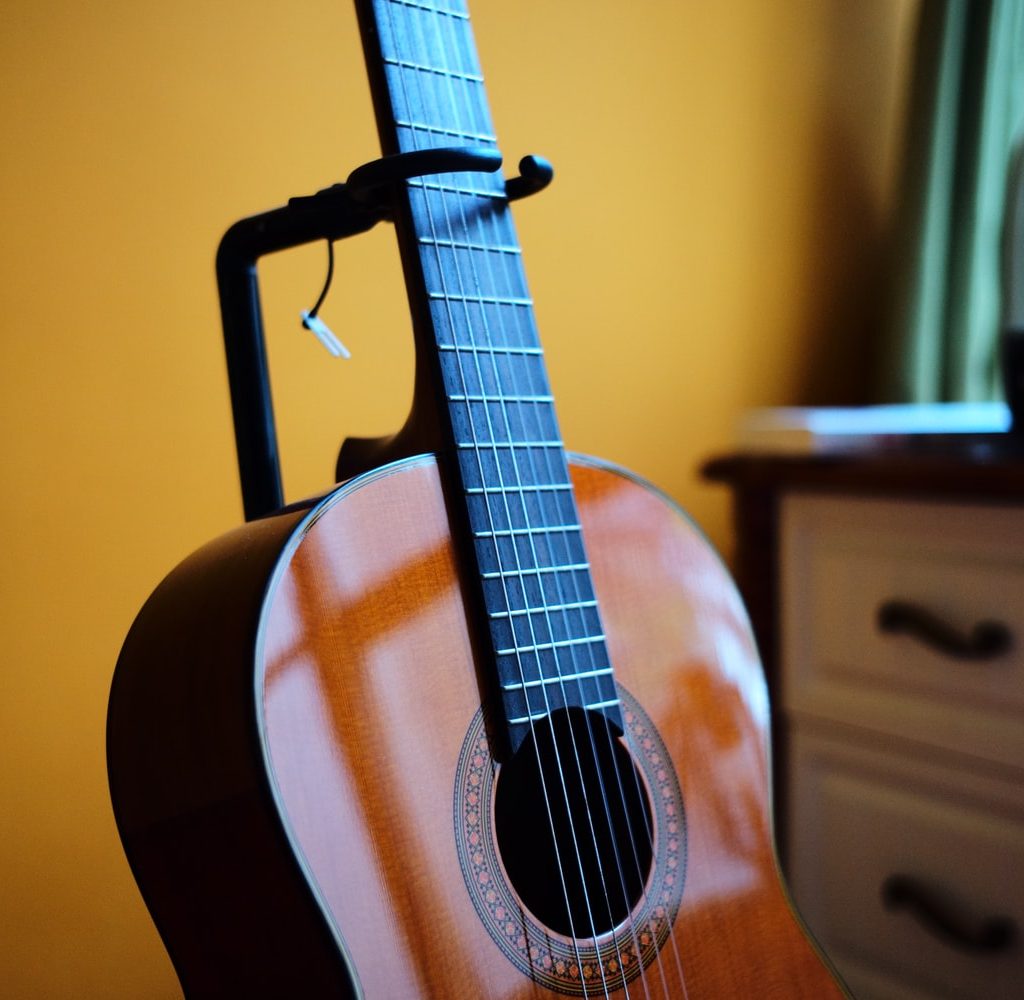Bad storage or care of a guitar can lead to damage to the instrument and of course this is not a good thing. So in today’s article, we would be teaching you how to use a guitar humidifier.

Photo by Brandon Wilson on Unsplash
Usually, when going to a guitar store to get a new guitar, the guitar is usually kept in a stable environment with controlled temperature and humidity. Once that guitar is bought, the onus now falls onto the buyer to keep the guitar humidified.
Reduced moisture can cause a crack and wood shrinkage. Too much moisture isn’t good either. Your guitar should be kept at a humidity of about 40–50 percent
Electric guitars and bass guitars most times do not have problems related to the environment due to the solidity of their construction. However, because the acoustic guitar does, it requires adequate care. Hence, the need for a guitar humidifier.
Why Do I Need A Guitar Humidifier?
It prevents damage to the body of the guitar
It preserves the sound quality of the guitar
It increases the longevity of the guitar, providing you with better value for money
It Prevents Damage To The Body Of The Guitar
When there is increased moisture in the environment, your guitar can swell up or get bloated. Also when the environment where the guitar is stored is too dry, the soundbox of the guitar shrinks inwards. This leads to a compression of the guitar.
A variety of issues can result from this including damage to the bridge of the guitar. In both cases of increased or no moisture, the guitar could get damaged so bad that it could become unplayable. A guitar humidifier would prevent this situation.
It Preserves The Sound Quality Of The Guitar
A very important part of acoustic guitars is the soundbox. The soundbox is the open portion of the guitar that produces the sound.
When there is an alteration in the normal temperature of a guitar there is damage to the soundbox. Depending on the degree of damage, other parts of the guitar, like the neck, could be affected too.
It Ensures Value For Money
We all want value for money with whatever we buy. Guitars cost quite a lot so it is very important you get value for your money. Guitar humidifiers help to prevent quick damage and ensure your instrument stays and functions for as long as possible.

Photo by Kenny Luo on Unsplash
How To Determine The Need For A Humidifier
It is important to know the humidity level of your guitar to know if a humidifier is necessary. To determine the humidity level of a guitar, a hygrometer is used.
Place the hygrometer in-between the strings at the soundhole to measure the humidity of the guitar.
Types Of Guitar Humidifiers And Method Of Usage
There are three main types of guitar humidifiers: the soundhole humidifier, the guitar case humidifier, and the room humidifier.
How To Use The Soundhole Humidifier
This guitar humidifier usually covers the soundhole. It is a rubber tube that is placed on top of the strings and runs down into the guitar. Soundhole humidifiers can also be placed between the strings.
They are the most popular type of guitar humidifier. They are affordable and easy to use. Soundhole humidifiers also work when the instrument is stored in a case.
How To Use The Guitar Case Humidifier
As its name implies, this type of humidifier is put in the guitar case rather than on or between the strings. It can be used when the soundhole humidifier does not fit.
The most common guitar case humidifiers are made of plastic or a material tube which makes it possible for water vapor to pass through.
How To Use The Room Humidifier
The room humidifier is used if you have a large store or collection of instruments. It can also be used if you prefer leaving your guitar out.
This humidifier ensures the temperature of the entire room is well regulated. It is best to have the room at a humidity of 40-50 percent and a temperature of around 70-75 degrees Fahrenheit.
With these conditions, rest assured that your guitar is safe. Better still, it is best to leave the door closed most times. The only issue with the room modifier is that it is expensive in comparison with the soundhole and guitar case humidifier.
Check out these other articles
- How To Buy A Used Guitar
- Where Can I Sell My Guitar For A Good Price?
- Ibanez GSR200 Vs Yamaha RBX170 – Which Should You Get?
- How To Polish Your Guitar Frets
- What Is A Baritone Guitar?
- How To Sell A Guitar
Conclusion
In conclusion, guitar humidifiers are very important for the full functioning and longevity of your guitar. It is important to check the temperature and humidity of the guitar regularly.
Also, ensure that humidifiers are not left in direct contact with the instrument. For a guitar case humidifier, it should not touch the wood and for a soundhole humidifier, ensure it is suspended from the strings.
Also, avoid exposure of instrument to extremes of temperature as this would definitely have an effect on the guitar.
How To Use A Guitar Humidifier – Frequently Asked Questions
How often should you use a guitar humidifier?
The frequency with which you use a guitar humidifier depends on the weather, season, and climate in which you live. In very dry areas or areas with cold winters, the humidifiers should be re-wet every 5-7 days and used often. In areas with humidity between 35-45 % humidifiers should be wet every 10 to 14 days and used fairly often. Guitar humidifiers prevent damage to your guitar by regulating humidity within your guitar.
Are humidifiers bad for guitars?
Humidifiers prevent your guitar from damages and crack during hot weather. So no, they are not bad for guitars if they are properly used. It is important that the right humidifier is used for your particular region and at the required frequency. Using a hydrometer will help to indicate the humidity in the guitar and whether a humidifier or even a dehumidifier is required. In some regions, the humidity could be too much for a guitar and a dehumidifier is required instead of a humidifier.
What is the best guitar humidifier?
There are three types of humidifiers. There is the soundhole humidifier, guitar case humidifier, and the room humidifier. In our opinion, one of the best humidifiers is the Music Nomad MN300 humidifier. It is safe, easy to use, and reasonably priced. It has a convenient flip-top for quick and easy monitoring.
It is long-lasting and requires low maintenance. This humidifier goes efficiently into place without need for hooks, clips or attachments. The sponge in the humidifier is easily accessible and retains lots of water.
How do I know my guitar is dry?
There are specific indicators that are evident when your guitar is dry. Low action is one of these. Low action occurs when your strings are very close to the fretboard and this could be indicative of a dry guitar. Also, if you notice a hump on the fretboard where the neck joins the body, this could indicate that the guitar is too dry. Sharp fret ends extended beyond the end of the fretboard could also indicate that your guitar is too dry. Using a humidifier will remedy all of these issues and keep you guitar healthy.
How do you rehydrate a guitar?
A guitar is rehydrated using a humidifier. Install a humidifier in a guitar and use as instructed. Humidifiers release moisture into the air in a safe way for your guitar. It is important to keep your guitar along with its humidifier in its guitar case as humidifiers are more efficient within an enclosed space. Also, ensure the lid of your guitar case is kept closed when the guitar is taken out of its case.
Should an acoustic guitar be kept in its case?
Definitely. An acoustic guitar should only be taken out of its case when it is to be played. Hanging your guitar or leaving it exposed to the elements is not good practice. Keeping your guitar in its case prevents the stings of the guitar from corrosion. It also prevents dust from accumulating on the guitar which could damage the guitar over time. By keeping your acoustic guitar in its case, you also help to protect the humidity within the guitar. This is even more important if you stay in a dry region with low humidity.
